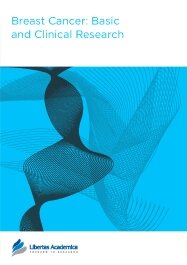

Publication Date: 17 Nov 2010
Type: Original Research
Journal: Breast Cancer: Basic and Clinical Research
doi: 10.4137/BCBCR.S5248

We investigated the relationship between mammary gland volume (MGV) of the breast as measured with three-dimensional chest computed tomography (CT) and breast cancer risk. Univariate analysis was used to assess the relationship between MGV and known risk factors in 427 healthy women. A case control study (97 cases and 194 controls) was conducted to assess breast cancer risk.
MGV was significantly smaller for postmenopausal women than for premenopausal women, and was significantly larger for women with a family history of breast cancer than for women without. MGV, body mass index (BMI), and rate of family history of breast cancer were significantly higher among breast cancer patients than among healthy women, and number of deliveries was significantly lower among breast cancer patients. In postmenopausal women, age at menarche was significantly younger for breast cancer patients. MGV correlated well with breast cancer risk factors. The highest odds ratio was 4.9 for premenopausal women with the largest MGV. Regardless of menopausal status, the greater the MGV, the higher the odds ratio. Our results constitute the first reliable data on the relationship between MGV and breast cancer obtained through exact volume analysis.
PDF (847.97 KB PDF FORMAT)
RIS citation (ENDNOTE, REFERENCE MANAGER, PROCITE, REFWORKS)
BibTex citation (BIBDESK, LATEX)
XML
PMC HTML

The submission process for manuscript publication in Breast Cancer: Basic and Clinical Research is as easy as A,B,C! Any minor hiccups I encountered were quickly addressed by Libertas' expert staff via prompt emails, and the timelines between initial submission and publication are surely the shortest on record! I will definitely be submitting future manuscripts to this journal, and look forward to working with their professional and expert team.

All authors are surveyed after their articles are published. Authors are asked to rate their experience in a variety of areas, and their responses help us to monitor our performance. Presented here are their responses in some key areas. No 'poor' or 'very poor' responses were received; these are represented in the 'other' category.See Our Results
Copyright © 2013 Libertas Academica Ltd (except open access articles and accompanying metadata and supplementary files.)
FacebookGoogle+Twitter
PinterestTumblrYouTube